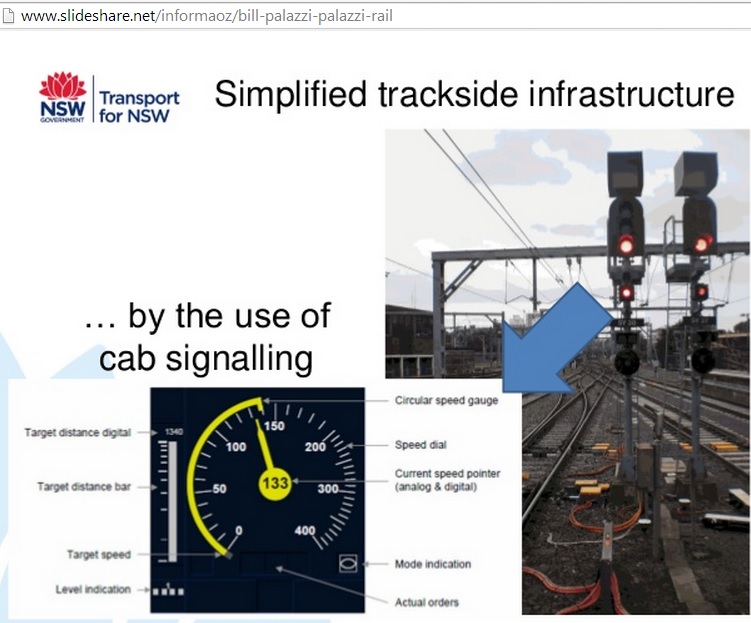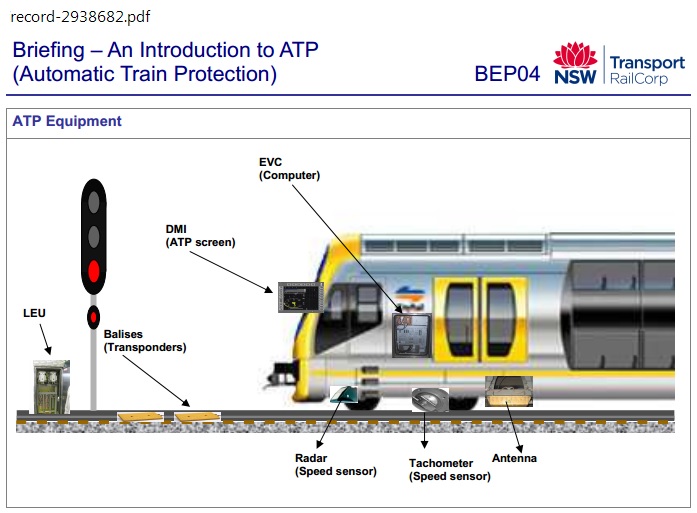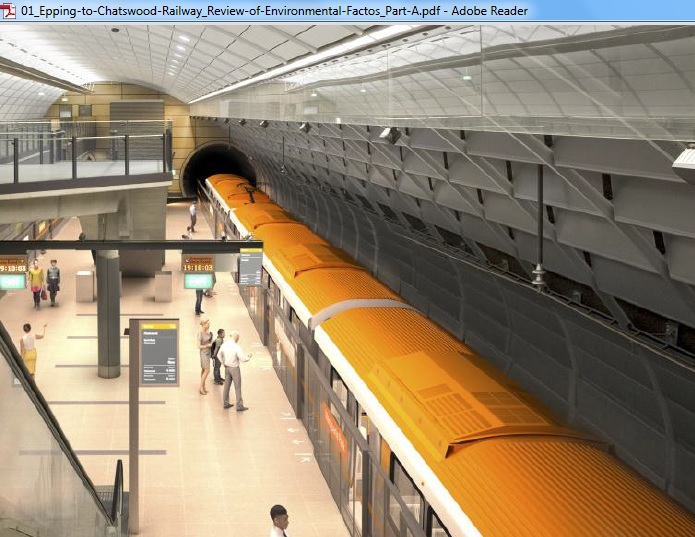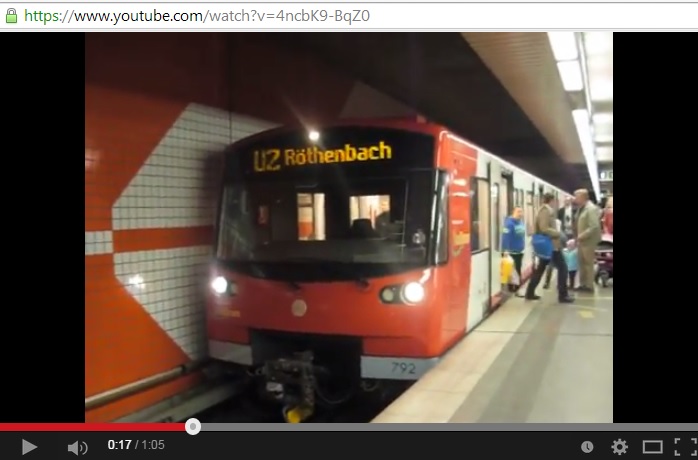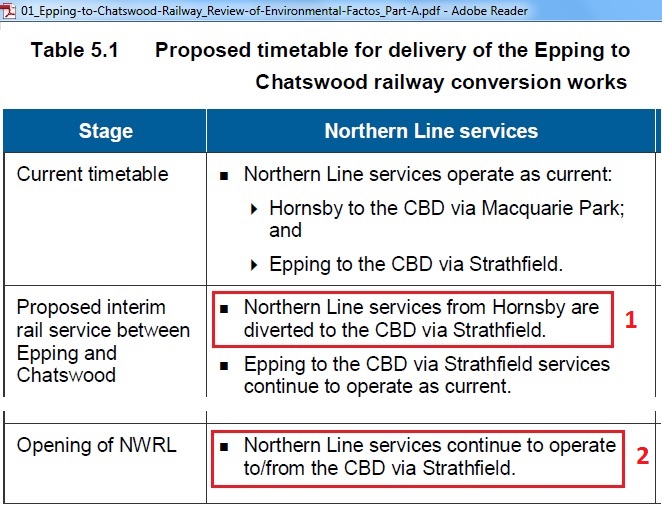In part 2 of this series we continue our excursion into Sydney’s rail world and look at whether this city spends its rail money wisely to prepare for an age of declining oil production. This period is now almost guaranteed as oil prices are too low to support investments both in brown fields and green fields, leading to an oil crisis in the years to come. No one knows when it is going to happen. Whether the world economy can survive gyrating oil prices is another question altogether. We have now analysts talking about subprime oil possibly triggering another financial crisis. And in this critical time the NSW government is doing an incredible experiment with Sydney’s rail network.
Contents:
(5) Automatic Train Protection
(6) Installation of platform screens
(7) 7 months line closure a No-No
So what are the transport priorities in the above context? In the previous post we saw that Sydney’s earlier investments in a comparatively modern signalling system in the Epping – Chatswood tunnel is proposed to be removed, to make room for driverless trains. This is a luxury given that a basic automatic train protection (ATP level 1) on 100s of kms of Sydney’s rail track and in 100s of rail cars is far from being completed. This, however, would be absolutely essential for increasing the number of trains in the whole system. That would be required in the case of even a fraction of motorists forced to take trains.
(5) Automatic Train Protection in Sydney
There are 4 levels of automation:
Fig 12: Grades of automation
http://www.uitp.org/sites/default/files/Metro%20automation%20-%20facts%20and%20figures.pdf
ATP = Automatic train protection, ATO = Automatic train operation, UTO = Unattended train operation
Where is Sydney in the above table? It is still working hard to get to GoA1.
Remember that the 2005 Waterfall accident report recommended automatic train protection to be implemented on all lines and trains:
Special Commission of Inquiry into the Waterfall Rail Accident
January 2005
RailCorp should progressively implement level 2 ATP with the features identified in chapter 7 of the final report.
• All new rolling stock should be designed to be compatible with at least level 2 ATP.
http://web.archive.org/web/20080626015521/http://www.cityrail.info/general/waterfall.pdf
So 10 years down the track where are we? Transport NSW describes the work (downloaded in Dec 2014)
The ATP program will be rolled out in three stages:
- Installation on the Oscars, Tangaras and 600 kilometres of track.
- Installation on the Waratah and Millennium trains.
- Installation of equipment to be rolled out across the rest of the electrified network.
Intercity ATP test trains have been commissioned and the trackside installation has been completed between Gosford and Wyong.
Trackside equipment has been fitted between Berowra and Gosford, and commissioning is underway.
Subject to the successful completion of these actions, it is expected that the first Oscar train, fitted with ATP equipment will operate between Berowra and Wyong in 2015.
In the coming months, Transport for NSW will issue a tender for design, construction and testing of ATP for a number of signals across the network.
The program is expected to be completed by 2021.
http://www.transport.nsw.gov.au/projects-automatic-train-protection
At the Rail Safety Conference 2014 (RISSB) Bill Palazzi gave this overview:
Rail Safety in NSW
March 2014
Fig 13: NSW roll-out of ATP – progress is slow
http://www.slideshare.net/informaoz/bill-palazzi-transport-for-nsw
ETCS= European Train Control System http://en.wikipedia.org/wiki/European_Train_Control_System
An update on future work can be found in a slide show at the ARA Train Control conference in August 2014
Fig 14: Planned cab signalling and trackside equipment
http://www.slideshare.net/informaoz/bill-palazzi-palazzi-rail
Fig 15: Equipment necessary for ATP (LEU = line side electronics unit, DMI = driver machine interface, EVC = European vital computer)
https://railsafe.org.au/automatic-train-protection
The above illustration is from an undated document BEP04
https://railsafe.org.au/trim/contractors-automatic-train-planning?RecordNumber=D2013%2F77567
Back to reality:
The latest annual report (#34, March 2014) of the Independent Transport Safety Regulator has found further project slippages:
- Type approval of lineside electronic units delayed until June 2015 (from February 2013)
- Commissioning into passenger service of 1st OSCAR train set with ATP equipment not before Sept 2015
- Completion of stage 1 ATP in June 2017 may not be achievable
If there were another accident caused by slow ATP implementation many questions will be asked.
It could well be that Hong Kong based MTR did not want to get involved with the technicalities and phasing of Sydney Trains’ roll-out plan for ATP and therefore decided for their own driverless trains. A full automation of a separately and foreign operated NWRL is not likley to bring much benefits to advancing ATP in the rest of Sydney’s network. Nothing is said in the NWRL documents how a transfer of know-how to Sydney Trains could work.
(6) Installation of platform screens
Fig 16: Platform screens depicted in picture 5.3 of REF Chapter 5.2.3
This is yet another way of stopping double deckers from using the tunnel because single deckers have more doors and in different positions.
Nuremberg solution
However, screen doors are not absolutely necessary as the example of the Nuremberg (population only 510 k) shows. Extract:
“Installing doors between track and platform (like on Paris’s metro line 14) would have been the superior solution, but since 6 stations which were already in full operation needed to be converted, fitting doors to the platform edges would have led to severe service disruptions and station closures
CCTV cameras and radio frequency barriers will detect persons and objects falling onto the track. In such a case the ATC will stop any approaching trains on that track immediately and alert the control centre, from where an operator can visually inspect the track bed at the platform over CCTV and then take the appropriate action.
For the creation of a new ATC system accommodating mixed ATC and non-ATC traffic federal grants and subsidies were awarded, offsetting some of the additional cost.
http://en.wikipedia.org/wiki/Nuremberg_U-Bahn
ATC= Automatic train control
Fig 17: Driverless metro trains DT3 in Nuremburg without platform screens.
Watch the first minute of this video on trains at Nuremberg Central station: https://www.youtube.com/watch?v=c5JDBaqUZ_Y
This and the retention of conventional signalling (also serving as a fall-back strategy) have allowed the transport authority to run driver operated trains in the same tunnel. Granted, Sydney is much busier but if safety were really a concern to the NSW government why not first install platform screens at Wynyard, Town Hall and Central? Would it be an excuse that double deckers are not able to stop at exactly where the screen doors are? How about that busy Chatswood interchange platform, where on one side you would have screen doors and on the other there are none?
Nuremberg experienced a lot of delays when developing the new technologies for the above solution and many lessons have been learnt. Siemens used the know-how acquired for introducing driver less trains in Paris
Nuremberg also introduced automatic trains DT3-F with driver cabin:
The DT3-F is a development of the DT3 trains in service on lines 1 and 2, and is equipped with a driver’s cab, allowing it to be used in manual mode on Line U1 and in automatic mode on lines U2 and U3. The cab can be removed later to convert the train for fully-automatic operation.
http://www.railwaygazette.com/news/urban/single-view/view/nuernberg-dt3-f-arrives.html
Fig 18: Automatic train DT3-F, equipped with driver cabin for transitional period
https://www.youtube.com/watch?v=4ncbK9-BqZ0
The following slide show describes technical details and costing:
http://www.metraut.es/2.-%20D.%20Kurt%20Graf%20%28Metro%20de%20Nuremberg%29.pdf
Note that a study on public acceptance of driverless trains (p 10) was done. Given the cynicism of Sydney’s public towards ever changing , party-politically motivated plans one wonders what the outcome of such a study would have been , had it been conducted before introducing them.
The lack of a good transitional plan leads to the next problem:
(7) Closing a rail line for 7 months is a No-No
In order to do the work described so far, the ECRL tunnel will have to be fully closed for a period of 7 months in 2018, not just on weekends or at night (as is usual for regular maintenance or upgrade work). A rail shuttle service Epping-Chatswood will already be started 4 months prior to this total closure. So the whole disruptions begin basically one year before the opening. 4 Hornsby starters on the Northern line now going through the tunnel would again go via Strathfield to the city but to Central or the CBD?
The Director General report says they will end in Central:
Fig 18: Number and route of trains after the opening of the NWRL (DG report Apr 2013). Hornsby starters on the Northern line (black) end in Central
https://majorprojects.affinitylive.com/public/39d7066570b75af31d0e003537bf2fd1/Director-General’s%20Environmental%20Assessment%20Report.pdf
But the REF document (Oct 2014) says they would go through the CBD without saying that this overrides the DG report.
Fig 19: Trains routes in REF document Oct 2014
#1 in Fig 19 is in contradiction to the DG’s statement in Fig 18 and #2 is ambiguous as there are 2 types of Northern Line services. We can have no confidence what will actually be decided in 3 years’ time. Why is this important? The following is an excerpt from a letter written by the Director Project Development to the NWRL team – published by the SMH in 2012:
“….these terminating trains [at Central] will put more interchanging passengers onto the already highly congested platform 16/17 and trains at Central. In order to alleviate such an interchange at Central a new grade separation may be needed, to maximise the capacity for trains travelling to the Harbour Bridge and to the City Circle to 20tph each. Such a grade separation has not been costed, however will be in the order of several hundred million dollars.”
Enjoy lengthy bus rides
For all passengers to/from stations on the ECRL a temporary transport plan is proposed to replace trains by buses.
Fig 20: Travel times of rail replacement buses. The train trip takes 17 min
Oops. This is like open heart surgery without a heart-lung machine.
[Ten News Sydney] Epping to Chatswood line to close for 7 months for metro conversion – 19/9/2014
14,000 passengers affected
https://www.youtube.com/watch?v=GCzsmp1ywz8
Imagine the M2 motorway had been closed completely for the widening job! It is unbelievable that in a democracy a government can get away with such a scheme. Ironically, if that were ever to work, then that would be a proof that the ECRL was actually not needed.
The former NSW Premier O’Farell (as opposition leader): “this service (Epping – Chatswood shuttle) should be free for the entire period that it continues as a shuttle service. That’s one way for State Labour government to pay for its past sins”
https://www.youtube.com/watch?v=YVIz1gvgL8s
Epping Chatswood Rail Link presentation. This video was proud that the new rail link was integrated with the rest of the network
https://www.youtube.com/watch?v=0lsBV7fItWY
No more.
Conclusion
The Sydney Morning Herald tried in numerous articles to wake up a sleeping public. They’ll wake up a couple of years down the track and realise they have been taken for an unexpected ride.
To be continued in part 3. It’ll be about platform congestion at the Chatswood interchange.
Previous post
30/12/2014
Sydney plans to dismantle rail infrastructure built just 6 years ago (part 1)
http://crudeoilpeak.info/sydney-plans-to-dismantle-rail-infrastructure-built-just-6-years-ago-part-1


